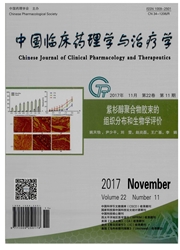

 中文摘要:
中文摘要:
目的:观察氯吡格雷预防长期中心静脉导管功能不良的临床疗效及安全性。方法:将124例应用长期中心静脉导管的维持性血液透析患者,随机分为氯吡格雷低剂量组、高剂量组和对照组,低剂量组、高剂量组分别每日给予氯吡格雷50、100mg口服,对照组仅用肝素盐水封管,观察6个月治疗期间长期中心静脉导管功能情况、首次尿激酶干预时间及尿激酶干预次数,并比较3组间凝血功能变化和药物不良反应。结果:氯吡格雷低剂量组和高剂量组6个月治疗期间导管功能不良发生的次数显著降低、尿激酶首次干预的时间推迟、尿激酶干预次数明显减少,与对照组比较有统计学意义(P〈0.05)。氯吡格雷高剂量组治疗6月后血小板计数(PLT)出现降低、凝血酶时间(PT)时间和活化部分凝血活酶时间(APTT)明显延长,与治疗后低剂量组比较有统计学意义(P〈0.05)。结论:口服50mg的氯吡格雷能减少长期中心静脉导管功能不良的发生,并且安全性好。
 英文摘要:
英文摘要:
AIM: To investigate the efficiency and safety of clopidogrel in preventing late mal- function in tunneled cuffed hemodialysis catheters. METHODS: 124 hemodialysis patients with tunneled cuffed hemodialysis catheters were randomly assigned to receive clopidogrel 50 mg per day or clopidogrel 100 mg per day and placebo, all followed for 6 months. The catheter function, use of urokinase, blood clotting index and medicine side-effect in three groups were compared. RESULTS. After treatment, the inci- dence rate of the catheter malfunction, the days of first intervention and the rate of use with the urokinase were all significantly decreased in cloidogrel 50 mg per day and clopidogrel 100 mg per day (P〈0.05). The count of PLT in clopidogrel 100 mg per day was less than those in clopidogrel 50 mg per day(P〈0.05). The time of PT and APTT in clopidogrel 100 mg per day was longer than those in elopidogrel 50 mg per day (P〈0.05). CONCLUSION: The clopidogrel 50 mg per day could prevent the late malfunction in tunneled cuffed hemodialysis catheters.
 同期刊论文项目
同期刊论文项目
 同项目期刊论文
同项目期刊论文
 期刊信息
期刊信息
